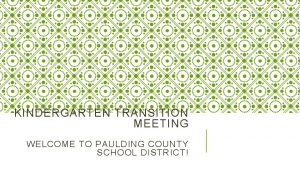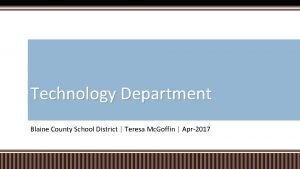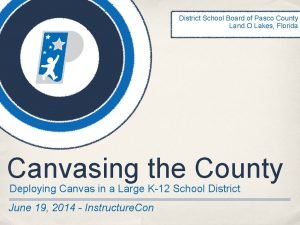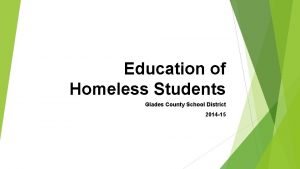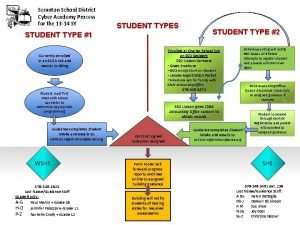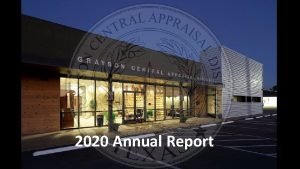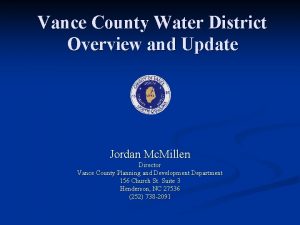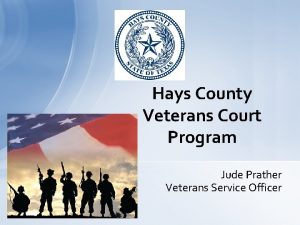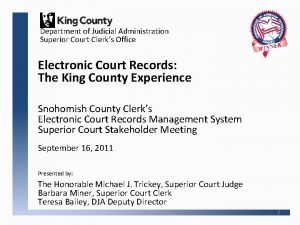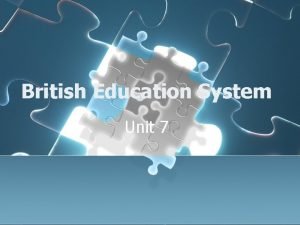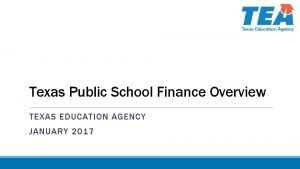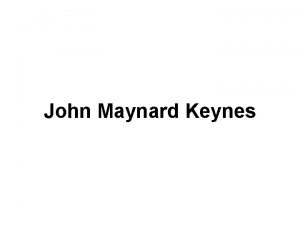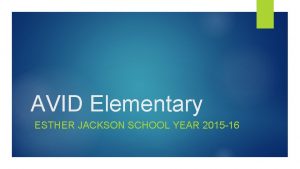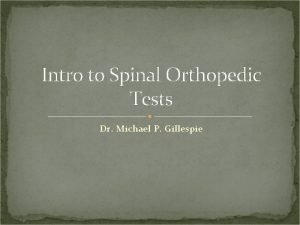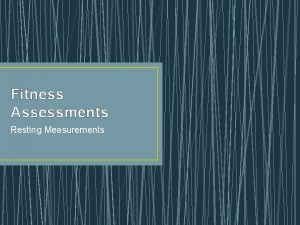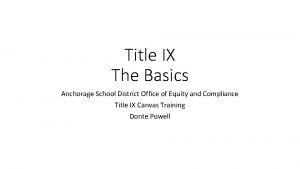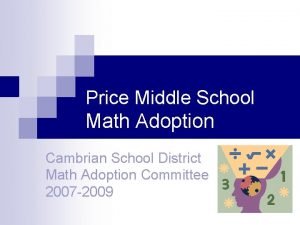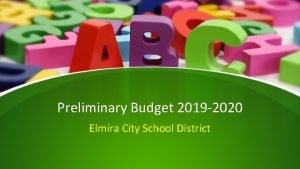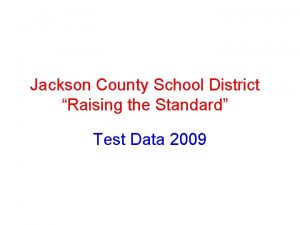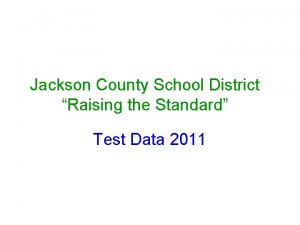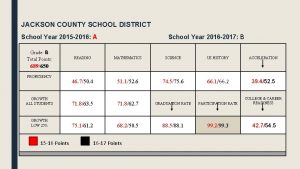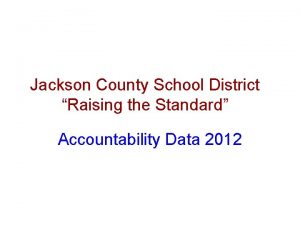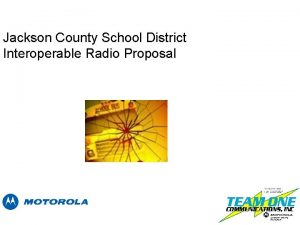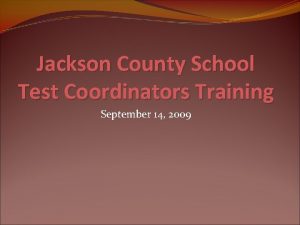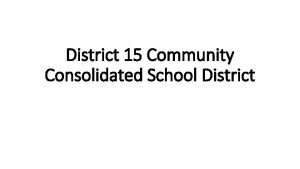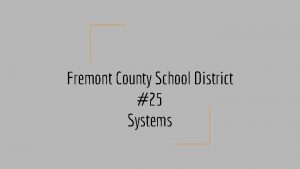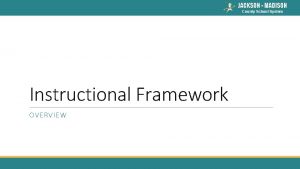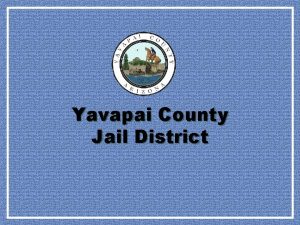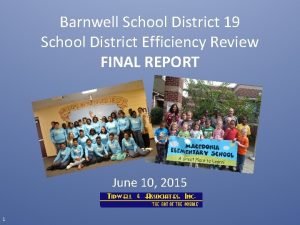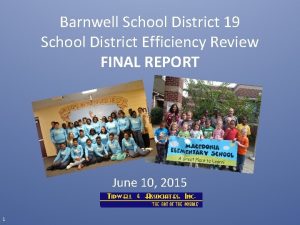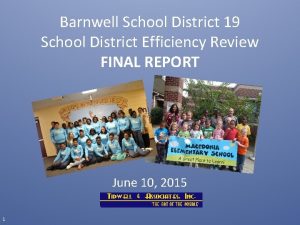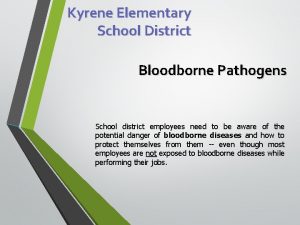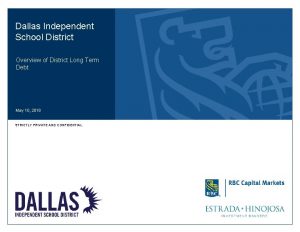Jackson County School District A overview of test







































- Slides: 39

Jackson County School District • A overview of test scores and cumulative data from 2001 – 2006 relative to the following: • Mississippi Curriculum Test • Writing Assessment • Subject Area Testing Program

Mississippi Curriculum Test • Administered each May to students in grades 2 – 8 • Students are tested in the areas of reading, language arts, and mathematics. • Mean scale score is the average score of all students tested. • % of students scoring proficient and advanced looks only at students in the upper quartiles. • Basis for state (Achievement and Growth) and most of federal (AYP) accountability models. • As mandated by NCLB, by 2014 ALL students MUST score either proficient or advanced.

JCSD Results • Based on the results of the 2006 state testing, the JCSD was one of only nine school districts in the state of Mississippi who had ALL schools rated as Level 5 and who met AYP (Adequate Yearly Progress) in ALL subgroups in EVERY school.

Second Grade – A Six Year Look at Growth in Mean Scale Scores • 26. 0 scale point increase in Reading 2001 - 2006 • 41. 6 scale point increase in Language Arts 2001 – 2006. • 29. 2 scale point increase in Math 2001 - 2006

Third Grade - A Six Year Look at Growth in Mean Scale Scores • 15. 2 scale point increase in Reading 2001 - 2006 • 28. 7 scale point increase in Language Arts 2001 – 2006 • 34. 5 scale point increase in Math 2001 - 2006

Fourth Grade – A Six Year Look at Growth in Mean Scale Scores • 11. 9 scale point increase in Reading 2001 - 2006 • 24. 7 scale point increase in Language Arts 2001 – 2006 • 23. 6 scale point increase in Math 2001 - 2006

Fifth Grade – A Six Year Look at Growth in Mean Scale Scores • 10. 2 scale point increase in Reading 2001 - 2006 • 33. 7 scale point increase in Language Arts 2001 – 2006. • 20. 8 scale point increase in Math 2001 - 2006

Sixth Grade – A Six Year Look at Growth in Mean Scale Scores • 7. 8 scale point increase in Reading 2001 - 2006 • 20. 8 scale point increase in Language Arts 2001 – 2006. • 20. 6 scale point increase in Math 2001 – 2006

Seventh Grade – A Six Year Look at Growth in Mean Scale Scores • • • 8. 2 scale point increase in Reading 2001 - 2006 11. 6 scale point increase in Language Arts 2001 – 2006. 23. 5 scale point increase in Math 2001 - 2006

Eighth Grade – A Six Year Look at Growth in Mean Scale Scores • 1. 6 scale point increase in Reading 2001 - 2006 • 5. 2 scale point increase in Language Arts 2001 – 2006. • 17. 8 scale point increase in Math 2001 - 2006

Second Grade – Percentages of Students Scoring Proficient and Advanced – Six Year Trend

Third Grade – Percentages of Students Scoring Proficient and Advanced – Six Year Trend

Fourth Grade – Percentages of Students Scoring Proficient and Advanced – Six Year Trend

Fifth Grade – Percentages of Students Scoring Proficient and Advanced – Six Year Trend

Sixth Grade – Percentages of Students Scoring Proficient and Advanced – Six Year Trend

Seventh Grade – Percentages of Students Scoring Proficient and Advanced – Six Year Trend

Eighth Grade – Percentages of Students Scoring Proficient and Advanced – Six Year Trend

Cohort Groups (Analyzing the same students from year to year…. . or comparing apples to apples!) Longitudinal Data 2003 – 2006 2 nd – 5 th Grade

Cohort Groups Cont. 3 rd Grade – 6 th Grade 2003 - 2006

Cohort Group 4 th Grade – 7 th Grade 2003 - 2006

Cohort Group 5 th Grade – 8 th Grade 2003 - 2006

Writing Assessment • Administered each March to students in grades 4 and 7. • Students receive a score of 1 – 4 based on writing proficiency shown on a writing prompt.

Subject Area Tests • Subject Area Tests are administered in the following areas: * Algebra I * English II (multiple choice and 1 writing prompt - informative * Biology * United States History

More on SATP • Students must pass all subject area tests in order to obtain a high school diploma. • Students not passing any assessment will be given three opportunities to be retested. • The 2001 administration of the SATP did not count towards graduation; therefore, a percentage of pass/fail was not included for that year.

Algebra 1 Data Comparison Mean Scores ~ Pass Rate MS and JCSD

English II Data Comparison Mean Scores ~ Pass Rate MS and JCSD

Biology Data Comparison Mean Scores ~ Pass Rate MS and JCSD

U. S. History Data Comparison Mean Scores ~ Pass Rate MS and JCSD

English II Writing Assessment Informative Mean Score Pass Rate

Mississippi Science Test • Administered to students in grades 5 and 8 • These tests are aligned with the Mississippi Science Framework 2001 and contains all multiple choice items with varying degrees of difficulty. • The tests are summative. That is the assessment covers grades 3 – 5 of the grade 5 test and grades 6 – 8 on the grade 8 test. • A field test was administered in 2005. • The first operational administration will take place in March 2007. Standard setting will take place in June 2007. Results will be reported in late summer 2007. • Beginning in 2008 all results will be distributed no later than June 15.

NAEP • The National Assessment of Educational Progress (NAEP) is a congressionally mandated project overseen by the National Center for Education Statistics (NCES) to continuously monitor the knowledge, skills, and performance of the nation’s children and youth.

“Nation’s Report Card” • As the “Nation’s Report Card, ” NAEP has measured and reported on a regular basis what America’s fourth, eighth, and twelfth graders know and can do since 1969.

NAEP Data • NAEP provides objective data about students’ performance at national, regional, and, as of 1990, state levels in reading, writing, mathematics, science, U. S. history, civics, geography, the arts, and other subjects.

NAEP Assessments • Who takes NAEP assessments? • Federal law requires all states that receive Title I funds participate in NAEP reading and mathematics assessments at 4 th and 8 th grades. • Schools that represent the demographics of the state are selected to participate; students within the schools are selected randomly.

NAEP Schedule January 22 to March 2, 2007 NAEP assessments will be administered. • Reading and Math (Grades 4 and 8) • Writing (Grade 8 and Grade 12) • ECUE, ECMS and SMHS (8 th Grade only) will participate in NAEP testing this spring.

NAEP Scores • 2007 NAEP Mathematics and Reading results should be available in the fall of 2007. • It is important to remember that no student scores or school scores or district scores are generated–only state scores for grades 4 and 8 and only national scores for grade 12.

Where do we go from here? • Continue developing/refining curriculum pacing guides and common assessments to insure ALL students are held to the very highest standards. District assessments are currently given every 4 ½ weeks. • Analyze data in a very deliberate manner to insure that students having difficulty with any skill are identified and remediated in a timely manner. • Continue implementation of new computer based learning programs aimed at improving scores of targeted subgroups. (i. e. Nova. Net, Fast. Forward, Compass Learning, etc. )

Steps to insure an increase in student achievement cont. • All schools have identified each and every student who scored minimal or basic on the 2006 MCT. These students are receiving additional help through a wide range of services (i. e before and after school tutorial services) • Schools have also identified students scoring in the lower 25% of the proficient range. These students are also given extra support to insure that they do show a decrease on the MCT. • Students in need of assistance were identified not only as individuals, but also as members of their NCLB subgroup. This will aid in insuring that ALL subgroups meet Adequate Yearly Progress.

Conclusion • The goal of the JSCD is to have 100% of students scoring either proficient and advanced BEFORE 2014. • We will achieve this goal by showing sustained growth over time with all student groups.
 Paulding county schools calendar
Paulding county schools calendar Skyward blaine county
Skyward blaine county Sumner county school district augmentedreality
Sumner county school district augmentedreality Colleton county school district dress code
Colleton county school district dress code Northern burlington school district
Northern burlington school district Pasco county canvas
Pasco county canvas Estill county schools
Estill county schools Glades county school board
Glades county school board Boyle county schools jobs
Boyle county schools jobs Summer school lodi unified
Summer school lodi unified Iswk uniform
Iswk uniform Scranton school district
Scranton school district Forsyth county schools overview
Forsyth county schools overview Theodore bedell jackson county ga
Theodore bedell jackson county ga Grayson tax appraisal
Grayson tax appraisal Vance county water district
Vance county water district Snohomish county fire district 7
Snohomish county fire district 7 Jude prather hays county
Jude prather hays county Northern sonoma county air pollution control district
Northern sonoma county air pollution control district Wasatch county fire
Wasatch county fire King county superior court ecr
King county superior court ecr Texas recapture districts
Texas recapture districts British school system presentation
British school system presentation British school system overview
British school system overview Texas public school finance overview
Texas public school finance overview Peeples middle school jackson ms
Peeples middle school jackson ms Jackson high school hours
Jackson high school hours Maynard jackson high school
Maynard jackson high school Queen esther jackson
Queen esther jackson Bakody test
Bakody test Nomogram for percent body fat
Nomogram for percent body fat Kyrene ivisions
Kyrene ivisions Anchorage school district office
Anchorage school district office Skyward family access south kitsap
Skyward family access south kitsap Cherry hill school district+sfra
Cherry hill school district+sfra Sacramento city unified school district v. rachel h
Sacramento city unified school district v. rachel h Sachem school district reopening plan
Sachem school district reopening plan Puyallup school district frontline
Puyallup school district frontline Cambrian school district
Cambrian school district Elmira city school district calendar
Elmira city school district calendar
